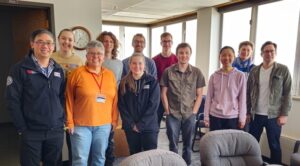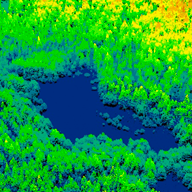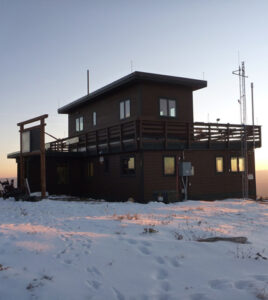-
 The University of Utah's Land-Atmosphere Interactions Research (LAIR) group is studying the role of wildfires from both the greenhouse gas and air quality perspectives. In projects funded by NOAA and DOE, the group is seeking to quantify and understand the impact of wildfires on the carbon budget, with a special focus on the American West. For this purpose, we combine biospheric and atmospheric models with extensive observational datasets, with an eye towards improving NOAA's CarbonTracker system and the Community Land Model (CLM), which has been supported extensively by DOE.
The University of Utah's Land-Atmosphere Interactions Research (LAIR) group is studying the role of wildfires from both the greenhouse gas and air quality perspectives. In projects funded by NOAA and DOE, the group is seeking to quantify and understand the impact of wildfires on the carbon budget, with a special focus on the American West. For this purpose, we combine biospheric and atmospheric models with extensive observational datasets, with an eye towards improving NOAA's CarbonTracker system and the Community Land Model (CLM), which has been supported extensively by DOE.In regards to air quality, we are examining the contributions of wildfires towards the enhancement of pollutants such as CO, O3, and PM2.5 in urban areas. High concentrations of these pollutants can cause adverse health effects, particularly in those with lung and heart disease and vulnerable populations such as children and the elderly. With support from Utah's Department of Environmental Quality, we are seeking to quantify the role of wildfires on degrading air quality across population centers in northern Utah.
In order to address the aforementioned objectives, accurate atmospheric modeling of fire plumes is necessary. To assess the accuracy of our atmospheric models and to improve upon it, we are working with the U.S. Forest Service's Missoula Fire Laboratoryto analyze data from the RxCADRE experiment.
-
 The Utah Remote Sensing Applications (URSA) Lab uses remote sensing data acquired from satellites, aircraft, and drones to explore applications solving real-world problems. We use data from a variety of different sensors, including hyperspectral, lidar, multispectral, and thermal infrared, to measure and map the Earth’s surface. We combine remote sensing with GIS to provide powerful tools to monitor changes in vegetation caused by drought and disturbance, assess wildland firefighter safety, and measure greenhouse gas plumes.
The Utah Remote Sensing Applications (URSA) Lab uses remote sensing data acquired from satellites, aircraft, and drones to explore applications solving real-world problems. We use data from a variety of different sensors, including hyperspectral, lidar, multispectral, and thermal infrared, to measure and map the Earth’s surface. We combine remote sensing with GIS to provide powerful tools to monitor changes in vegetation caused by drought and disturbance, assess wildland firefighter safety, and measure greenhouse gas plumes. -
 The Hallar Aerosol Research Team (HART) seeks to understand connections between between the atmosphere, biosphere, and climate, along with the impact of anthropogenic emissions on these connections. The group is made up of students and researchers from many different scientific backgrounds, including atmospheric science, chemistry, biology, mathematics, snow hydrology, and physics. The group publishes frequently in a variety of fields and disciplines including aerosol science, cloud microphysics, instrumentation, and atmospheric chemistry. Dr. Hallar is director of a mountain-top aerosol research facility called Storm Peak Laboratory, located in Steamboat Springs, Colorado, where team members are able to visit and work developing new instrumentation and field work skills.
The Hallar Aerosol Research Team (HART) seeks to understand connections between between the atmosphere, biosphere, and climate, along with the impact of anthropogenic emissions on these connections. The group is made up of students and researchers from many different scientific backgrounds, including atmospheric science, chemistry, biology, mathematics, snow hydrology, and physics. The group publishes frequently in a variety of fields and disciplines including aerosol science, cloud microphysics, instrumentation, and atmospheric chemistry. Dr. Hallar is director of a mountain-top aerosol research facility called Storm Peak Laboratory, located in Steamboat Springs, Colorado, where team members are able to visit and work developing new instrumentation and field work skills. -
 Through $5M funding by the U.S. National Science Foundation (NSF) and $3.75M funding by the Natural Sciences and Engineering Research Council of Canada (NSERC), the University of Utah and University of Calgary will establish and co-lead the U.S.-Canada Center on Climate-Resilient Western Interconnected Grid.
Through $5M funding by the U.S. National Science Foundation (NSF) and $3.75M funding by the Natural Sciences and Engineering Research Council of Canada (NSERC), the University of Utah and University of Calgary will establish and co-lead the U.S.-Canada Center on Climate-Resilient Western Interconnected Grid.The Western Interconnected Grid, commonly known as “the Western Interconnection,” is one of the two major interconnected power grids in North America, which stretches from the northern edge of British Columbia, Canada to the border of Baja, Mexico, and from the California coast to the Rockies, and serves roughly 80 million people over 1.8 million square miles across two Canadian provinces and fourteen western states in the United States. The Western Interconnection is the backbone of one of the largest regional economic engines in the world.
Masood Parvania, associate professor of Electrical and Computer Engineering at the University of Utah’s John and Marcia Price College of Engineering will co-lead the center along with Hamid Zareipour, professor of Electrical and Software Engineering at the University of Calgary’s Schulich School Engineering.
At the University of Utah, the center involves co-principal investigators Valerio Pascucci, professor at the Scientific Computing and Imaging Institute and Kahlert School of Computing, William Andregg, director of the Wilkes Center for Climate Science and Policy, and Divya Chandrasekhar, associate professor in the Department of City and Metropolitan Planning in the College of Architecture and Planning, among multiple other partners and faculty.
The U.S.-Canada Center on Climate-Resilient Western Interconnected Grid creates an interdisciplinary and international partnership that brings together leading experts in power engineering, climate, forestry, data, policy, and social sciences, as well as industry, entrepreneurs and community knowledge holders from a network of 35 partners across academia, industry, government, and communities with the mission of enhancing the power grid resilience to the rising frequency, intensity, and duration of extreme weather events, such as wildfires and heatwaves.
The academic members of the center include the University of Utah, University of California San Diego’s WIFIRE lab, University of New Mexico, and Desert Research Institute in the U.S., as well as University of Calgary, University of British Columbia, University of British Columbia Okanagan Campus, University of Alberta, University of Saskatchewan, University of Regina and Thompson Rivers University in Canada.